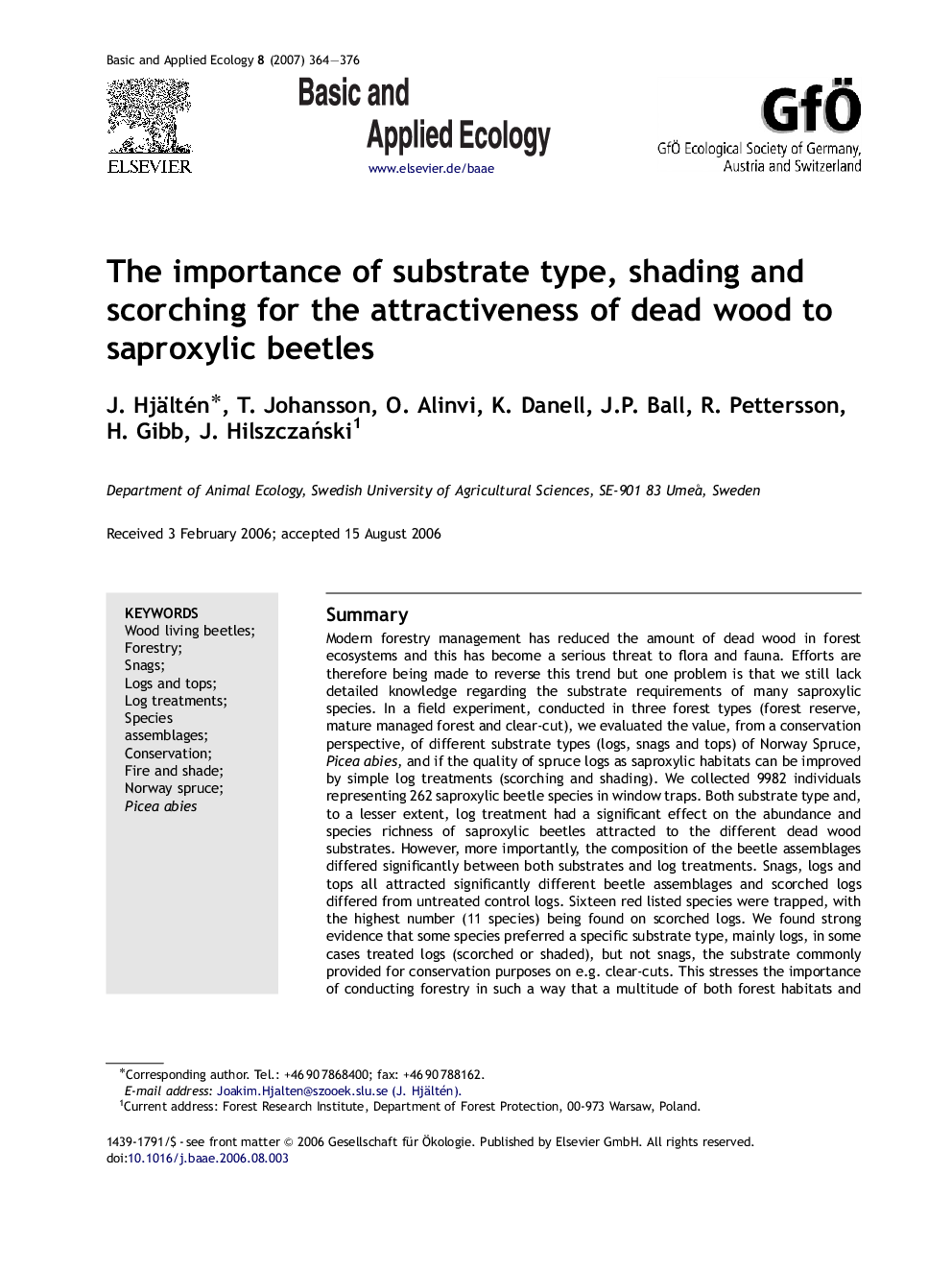| Article ID | Journal | Published Year | Pages | File Type |
|---|---|---|---|---|
| 4384766 | Basic and Applied Ecology | 2007 | 13 Pages |
SummaryModern forestry management has reduced the amount of dead wood in forest ecosystems and this has become a serious threat to flora and fauna. Efforts are therefore being made to reverse this trend but one problem is that we still lack detailed knowledge regarding the substrate requirements of many saproxylic species. In a field experiment, conducted in three forest types (forest reserve, mature managed forest and clear-cut), we evaluated the value, from a conservation perspective, of different substrate types (logs, snags and tops) of Norway Spruce, Picea abies, and if the quality of spruce logs as saproxylic habitats can be improved by simple log treatments (scorching and shading). We collected 9982 individuals representing 262 saproxylic beetle species in window traps. Both substrate type and, to a lesser extent, log treatment had a significant effect on the abundance and species richness of saproxylic beetles attracted to the different dead wood substrates. However, more importantly, the composition of the beetle assemblages differed significantly between both substrates and log treatments. Snags, logs and tops all attracted significantly different beetle assemblages and scorched logs differed from untreated control logs. Sixteen red listed species were trapped, with the highest number (11 species) being found on scorched logs. We found strong evidence that some species preferred a specific substrate type, mainly logs, in some cases treated logs (scorched or shaded), but not snags, the substrate commonly provided for conservation purposes on e.g. clear-cuts. This stresses the importance of conducting forestry in such a way that a multitude of both forest habitats and dead wood substrates are available continuously in the forest landscape to maintain biodiversity.
ZusammenfassungDie moderne Forstwirtschaft hat die Menge von Totholz in Waldökosystemen reduziert, und dies ist zu einer ernsten Bedrohung für die Flora und Fauna geworden. Daher gibt es Bestrebungen diesen Trend umzukehren, aber der Mangel an detaillierten Kenntnissen zu den Substratansprüchen vieler saproxylischer Arten ist dabei ein Problem. In einem Freilandexperiment, das in drei Waldtypen (Waldschutzgebiet, reifer Wirtschaftswald und Kahlschlag) durchgeführt wurde, untersuchten wir die Bedeutung von unterschiedlichen Substrattypen (Stämme, Stümpfe und Baumspitzen der Fichte, Picea abies) für den Naturschutz sowie die Frage, ob die Eignung von Stamm-Totholz als saproxylische Habitate durch einfache Maßnahmen (Versengen, Beschatten) verbessert werden kann. Mit Fensterfallen fingen wir 9982 Individuen aus 262 saproxylischen Käferarten. Der Substrattyp und—in geringerem Maße—die Behandlung des Stamm-Totholzes hatten einen signifikanten Effekt auf die Abundanz und den Artenreichtum der Käfer. Jedoch wichtiger war die Tatsache, dass beide Parameter signifikanten Einfluss auf die Zusammensetzung der Käfergemeinschaften hatten. Baumstümpfe, Stammholz und Baumspitzen zogen signifikant unterschiedliche Käfergemeinschaften an, und versengtes Stammholz unterschied sich von unbehandelten Kontrollen. Sechzehn Rote-Liste-Arten wurden registriert, die höchste Artenzahl an versengtem Stammholz. Wir fanden deutliche Belege, dass einige Arten bestimmte Substrattypen bevorzugten, jedoch nicht die Baumstümpfe, die gewöhnlich für Naturschutzzwecke stehen gelassen werden. Dies hebt die Wichtigkeit hevor, forstliche Eingriffe so zu gestalten, dass eine Vielfalt von Waldhabitaten und Totholzsubstraten kontinuierlich verfügbar bleibt, um die Biodiversität von Waldlandschaften zu erhalten.
